Contents
- 1 Importance of cow
- 2 Vrat associated with the cow
- 3 Spiritual importance of Govatsa Dwadashi
- 4 Fasting under Govatsa Dwadashi
- 5 Science underlying the worship of cow on Govatsa Dwadashi
In a legend, it is mentioned that from the Great Churning of the ocean (samudramanthan) five wish-fulfilling cows (kamadhenus) emerged. Among these five wish-fulfilling cows, a divine cow Nandâ had also emerged. This vowed religious observance is performed to worship this divine cow Nanda. On this day, married women (soubhagyavatis) undertake a fast partaking of only one meal, and either in the morning or evening; worship an embellished cow and her calf.
1 Importance of cow
1A Cow is a very useful animal
The cow, who is sattva-predominant, nourishes the society with her milk and lends fertility to the soil with the manure of her dung, is worthy of worship everywhere. The Hindus call the cow as Mother with gratitude. Where there is protection and nurture of cow, the person, society and nation do not lack in prosperity.
1B Principles of all Deities are attracted in the cow
Bhagwan Srikrushna is fond of cows. Dattatreya is also accompanied by a cow. The feature of the cow is that it attracts the Principles of all the Deities. Hence, it is said that all Deities dwell in the cow. The components obtained from the cow namely, milk, ghee, cow-dung or cow’s urine have the Principle of Deities accumulated in them.
1C The premise is purified by cow urine
Most of the Ayurvedic medicines contain cow urine. By sprinkling the cow urine in the premise, the destroyer frequencies of Deities’ Principles are emitted in the environment because of which the negative energies in the premise are driven away and the environment there becomes pure. The Panchagavya, that is, a mixture of five substances including cow urine, is important for internal and external purification during the ritual of worship.
2 Vrat associated with the cow
According to Shaka Samvat the day of Ashwin Krushna Dwadashi and according to Vikram Samvat, Kartik Krushna Dwadashi is called Govatsa Dwadashi.
3 Spiritual importance of Govatsa Dwadashi
3A Protection of environment from the instability generated during the period of Deepavali
During the period of Dipavali the flow of Shakti filled with energy is activated in the environment. As a result the Earth’s environment is harmed at a subtle level. This causes instability in the environment. In order to save from the consequent harm, before Deepavali, the vrat of Govatsa Dwadashi has been recommended. On the day of Govatsa Dwadashi through the manifest frequencies of Sri Vishnu the stability is maintained in the environment.
3B Expressing gratitude towards the cow Kamadhenu from the subtle Vishnu region
On Govatsa Dwadashi, the Absolute Water Principle-dominant frequencies of Sri Vishnu from the subtle Vishnu region are carried to the Universe by a cow called Kamadhenu from that region. To express gratitude towards her, a cow is worshipped on this day.
3C Gaining benefit of frequencies of Sri Vishnu
On the day of Govatsa Dwadashi, due to absorption of the frequencies of the manifest form of Sri Vishnu in the cow, there is emission of the Chaitanya-filled frequencies of Sri Vishnu from the atmosphere to the Universe in the form of a cover. The person worshipping a cow gets the benefit of these frequencies of Sri Vishnu.
4 Fasting under Govatsa Dwadashi
This vrat is done by consuming one meal. However, in the meal cow milk and the dishes made from it and fried foods like bhujiya, pakaudi etc. are not consumed.
5 Science underlying the worship of cow
in the morning or evening on Govatsa Dwadashi
In the morning or evening the frequencies of Sri Vishnu in manifest form are attracted in the cow in higher proportion. These frequencies accelerate the unmanifest frequencies of Sri Vishnu in 10 % more proportion.
5A Worship of cow
- First a resolve is made to worship the cow.
- Then consecrated rice is offered to the cow and she is invoked.
- Then consecrated rice is offered and a seat is offered to her.
- Thereafter, the rituals like padya, arghya, bathing etc. are done.
- Cloth is offered.
- Then sandalwood paste, turmeric and vermilion are applied to her.
- Sandalwood is offered.
- Then ornaments are offered.
- A garland is offered.
- Thereafter ‘nyas’ is made by touching every part of the cow.
- After the worship of cow, sandalwood paste, turmeric, vermilion and a garland etc. are offered to the calf.
- Then two incense sticks are waved in front of the cow and the calf.
- Then a lit lamp is waved in front of them.
- Then Holy sacrament is offered to them.
- Then circumambulation is done around the cow.
- A garland of Tulasi leaves is offered and flowers are offered after chanting mantras.
- Then again arghya is offered and the worship is concluded.
After the worship, the cow should again be paid obeisance with spiritual emotion. If for any reason the worship of cow with sixteen substances is not possible, we can worship with five substances also. The worship of cow teaches us to view Divine Principle in every animate and inanimate object. The person observing a vrat acquires all the pleasures of life.

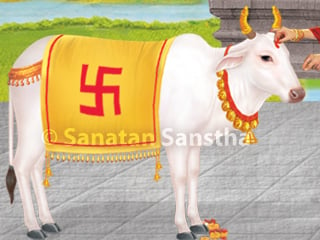
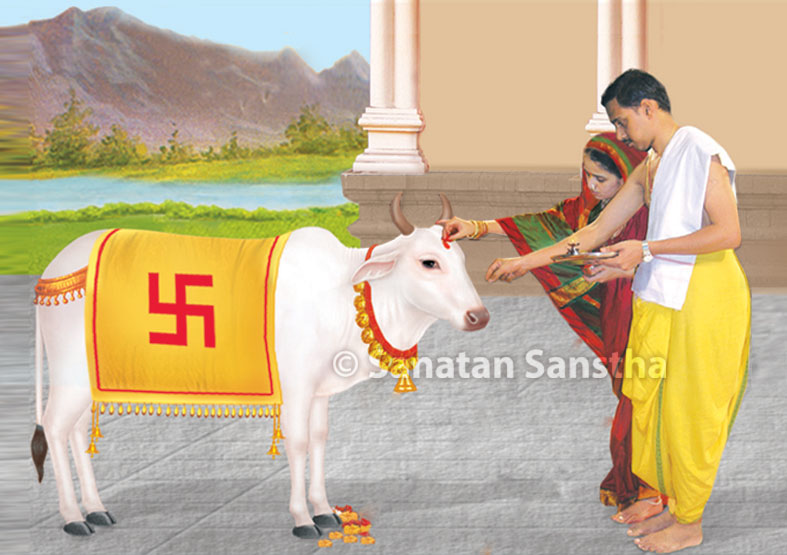
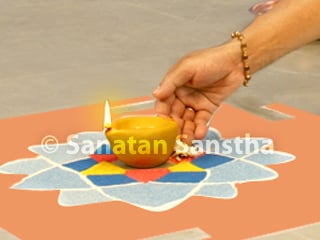 Why is Yamadipadan performed during Diwali ?
Why is Yamadipadan performed during Diwali ?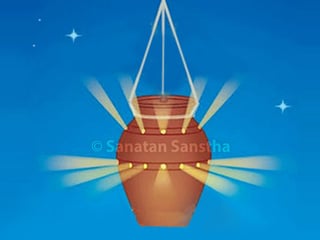 Akash kandil - Diwali Lantern
Akash kandil - Diwali Lantern Model forts built during Deepavali awaken ‘Kshatra-vrutti’!
Model forts built during Deepavali awaken ‘Kshatra-vrutti’!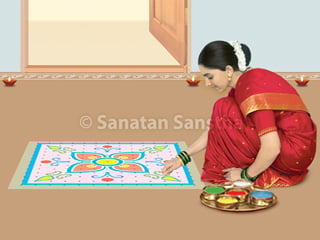 Diwali Festival - Festival of Lights
Diwali Festival - Festival of Lights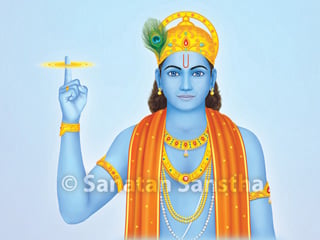 How to celebrate Narak Chaturdashi?
How to celebrate Narak Chaturdashi?